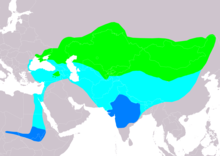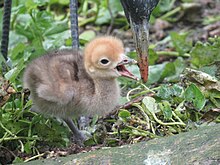Demoiselle crane
| Demoiselle crane | |
|---|---|

| |
| Flock at Tal Chhapar Sanctuary, Churu, Rajasthan | |
| Scientific classification | |
| Domain: | Eukaryota |
| Kingdom: | Animalia |
| Phylum: | Chordata |
| Class: | Aves |
| Order: | Gruiformes |
| Family: | Gruidae |
| Genus: | Grus |
| Species: | G. virgo
|
| Binomial name | |
| Grus virgo | |

| |
| Range of G. virgo Breeding Passage Non-breeding
| |
| Synonyms | |
| |
The demoiselle crane (Grus virgo) is a species of
Description

The demoiselle is 85–100 cm (33.5–39.5 in) long, 76 cm (30 in) tall and has a 155–180 cm (61–71 in) wingspan. It weighs 2–3 kg (4.4–6.6 lb). It is the smallest species of crane.[4][5] The demoiselle crane is slightly smaller than the common crane but has similar plumage. It has a long white neck stripe and the black on the foreneck extends down over the chest in a plume.
It has a loud
The demoiselle was so named by Queen Marie Antoinette, for its delicate and maiden-like appearance.[6]
In culture


The demoiselle crane is known as the koonj/kurjan in the languages of North India, and figure prominently in the literature, poetry and idiom of the region. Beautiful women are often compared to the koonj because its long and thin shape is considered graceful. Metaphorical references are also often made to the koonj for people who have ventured far from home or undertaken hazardous journeys.[7]

The name koonj is derived from the
The flying formation of the koonj during migrations also inspired infantry formations in ancient India. The Mahabharata epic describes both warring sides adopting the koonj formation on the second day of the Kurukshetra War.[9]
References
- . Retrieved 14 February 2022.
- ^ "Appendices | CITES". cites.org. Retrieved 2022-01-14.
- ^ onomatopoeic, deriving from the Sanskrit 'kraunch', the origin of the word crane itself ...
- ^ Demoiselle Crane, Int. Crane Foundation
- ISBN 978-0-19-563731-1.
- ^ "Demoiselle Crane | International Crane Foundation". www.savingcranes.org. Retrieved 2018-10-22.
- ISBN 978-81-317-0417-2.
... kunj: more properly koonj is a demoiselle crane. The word is used metaphorically for a young bride far from her home ...
- ISBN 978-81-7650-190-3.
... Valmiki saw a pair of kraunch (cranes) birds making love. Suddenly, a hunter killed the male kraunch with an arrow. Valmiki was moved by the cries of the female ... Valmiki's pain was expressed through a shloka ... The first man-composed meter ...
- ISBN 978-0-595-40188-8.
... The second day: Two kraunchas ... Yudhishtira decides to form his legions in the vyuha called the krauncha, after the crane ...
External links
- eBird Species Factsheet
- Demoiselle crane at Animal Diversity Web
- Demoiselle Crane (Anthropoides virgo) from Cranes of the World (1983) by Paul Johnsgard

